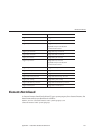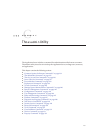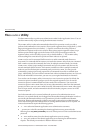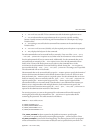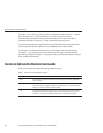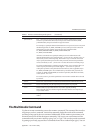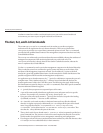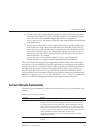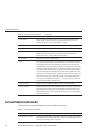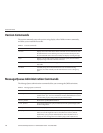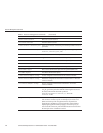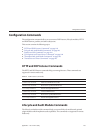
■
The list command treats this complete dotted name as the complete name of a parent
node in the abstract hierarchy. Upon providing this name to list command, it simply
returns the names of the immediate children at that level. For example,list
server.applications.web-module will list all the web modules deployed to the domain
or the default server.
■
The get and set commands treat this complete dotted name as the fully qualied name
of the attribute of a node (whose dotted name itself is the name that you get when you
remove the last part of this dotted name) and it gets/sets the value of that attribute. This
is true if such an attribute exists. You will never start with this case because in order to
nd out the names of attributes of a particular node in the hierarchy, you must use the
wildcard character *. For example,
server.applications.web-module.JSPWiki.context-root will return the
context-root of the web-application deployed to the domain or default server.
The list command is the progenitor of navigational capabilities of these three commands. If
you want to set or get attributes of a particular application server subsystem, you must know
its dotted name. The list command is the one which can guide you to nd the dotted name of
that subsystem. For example, to nd out the modied date (attribute) of a particular le in a
large le system that starts with /. First you must nd out the location of that le in the le
system, and then look at its attributes. Therefore, two of the rst commands to understand the
hierarchies in appserver are: * list "*" and <command>* list * --monitor. Consult the get
set or list commands manpages to identify the sorted output of these commands.
Server Lifecycle Commands
The server lifecycle commands are commands that create, delete, or start, stop a domain, or an
instance.
TABLEC–2 ServerLifecycle Commands
Command Denition
create-domain Creates theconguration of a domain. A domainis an administrative
namespace. Every domain has aconguration, which is stored ina set of les.
Any number ofdomains each of which has adistinct administrative identity
can be createdin a given installation of applicationserver. A domain can exist
independent of otherdomains. Any user who has accessto the asadmin script
on a givensystem can create a domain andstore its conguration in a folderof
choice. By default,the domain conguration is createdin the
install_dir/domains directory. You canoverride this location to storethe
conguration elsewhere.
delete-domain Deletes the nameddomain. The domain must already existand must be
stopped.
Server LifecycleCommands
AppendixC • Theasadmin Utility 237



